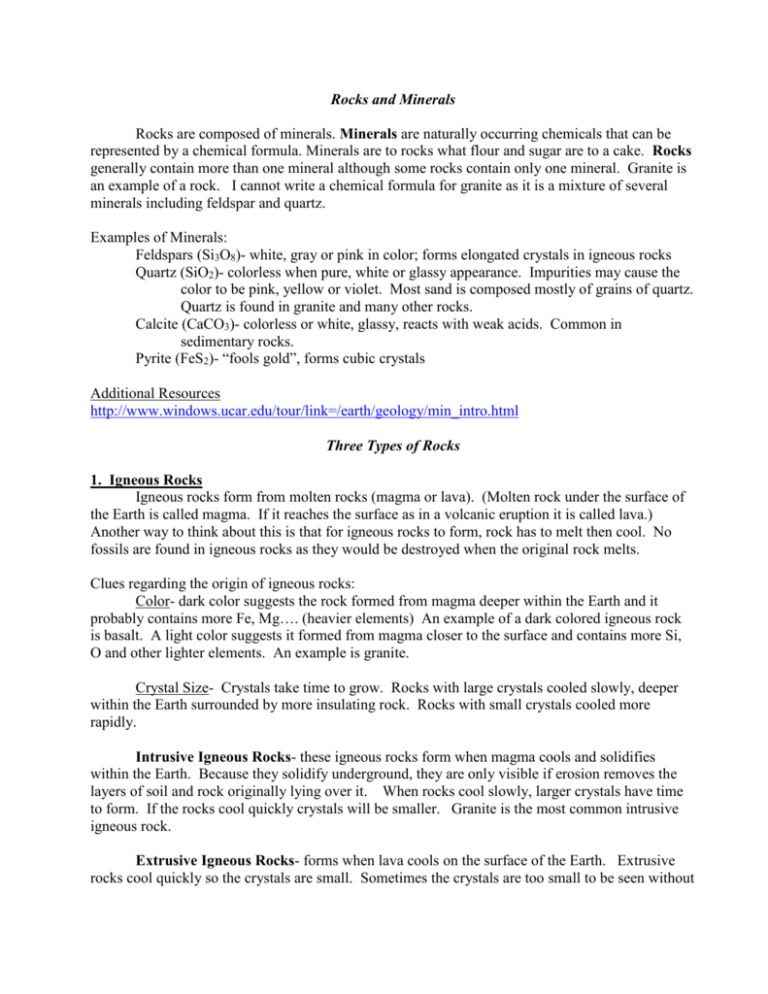Rocks and Minerals - Bennatti
advertisement

Rocks and Minerals Rocks are composed of minerals. Minerals are naturally occurring chemicals that can be represented by a chemical formula. Minerals are to rocks what flour and sugar are to a cake. Rocks generally contain more than one mineral although some rocks contain only one mineral. Granite is an example of a rock. I cannot write a chemical formula for granite as it is a mixture of several minerals including feldspar and quartz. Examples of Minerals: Feldspars (Si3O8)- white, gray or pink in color; forms elongated crystals in igneous rocks Quartz (SiO2)- colorless when pure, white or glassy appearance. Impurities may cause the color to be pink, yellow or violet. Most sand is composed mostly of grains of quartz. Quartz is found in granite and many other rocks. Calcite (CaCO3)- colorless or white, glassy, reacts with weak acids. Common in sedimentary rocks. Pyrite (FeS2)- “fools gold”, forms cubic crystals Additional Resources http://www.windows.ucar.edu/tour/link=/earth/geology/min_intro.html Three Types of Rocks 1. Igneous Rocks Igneous rocks form from molten rocks (magma or lava). (Molten rock under the surface of the Earth is called magma. If it reaches the surface as in a volcanic eruption it is called lava.) Another way to think about this is that for igneous rocks to form, rock has to melt then cool. No fossils are found in igneous rocks as they would be destroyed when the original rock melts. Clues regarding the origin of igneous rocks: Color- dark color suggests the rock formed from magma deeper within the Earth and it probably contains more Fe, Mg…. (heavier elements) An example of a dark colored igneous rock is basalt. A light color suggests it formed from magma closer to the surface and contains more Si, O and other lighter elements. An example is granite. Crystal Size- Crystals take time to grow. Rocks with large crystals cooled slowly, deeper within the Earth surrounded by more insulating rock. Rocks with small crystals cooled more rapidly. Intrusive Igneous Rocks- these igneous rocks form when magma cools and solidifies within the Earth. Because they solidify underground, they are only visible if erosion removes the layers of soil and rock originally lying over it. When rocks cool slowly, larger crystals have time to form. If the rocks cool quickly crystals will be smaller. Granite is the most common intrusive igneous rock. Extrusive Igneous Rocks- forms when lava cools on the surface of the Earth. Extrusive rocks cool quickly so the crystals are small. Sometimes the crystals are too small to be seen without a microscope. Obsidian cools so quickly the rocks are as smooth as glass. Basalt is the most common extrusive igneous rock. 2. Sedimentary rock Sedimentary rock forms when layers of sediment harden. The sediments may consist of clay, sand or gravel, plant or animal remains, or chemicals that settle out of solution on the bottom of lakes or the ocean. Weathering breaks down existing rocks into smaller pieces. The fragments are transported by water and wind through the process of erosion. As water or wind deposits this material in a new location it may eventually form sedimentary rock. Examples of sedimentary rock include sandstone, shale, limestone and coal. Coal is not formed from rock fragments but from the remains of plants that died millions of years ago and were trapped under layers of water and sediments. Heat, pressure and low oxygen levels cause the vegetation to change over millions of years into coal. The sites of coal deposits were once ancient swamps. Fossils may be found in sedimentary rocks. 3. Metamorphic Rocks Metamorphic rocks form when heat, pressure or chemicals change existing rocks. Metamorphic rocks often resemble the rocks from which they form. Sandstone is a sedimentary rock which is converted into quartzite, a metamorphic rock. Limestone (a sedimentary rock) is converted into marble (a metamorphic rock). Shale is a sedimentary rock that is converted by heat and pressure into slate, a metamorphic rock. Slate can then be converted by more heat and pressure into schist, then into gneiss (pronounced “nice”). Other Resources http://www.windows.ucar.edu/tour/link=/earth/geology/rocks_intro.html Review Questions 1. If you were searching for fossils, which of the three types of rocks would you check? 2. Which type of rock forms from existing rocks that are changed by heat or pressure? 3. Which type of rock forms from rock that has melted? 4. Which type of rock forms from particles or pieces of rock that are cemented together? 5. What is the difference between rocks and minerals? 6. Classify each of the following as either a rock or a mineral. _____________feldspar _____________quartz _____________granite _____________sandstone _____________pyrite ____________basalt ___________NaCl 7. What is the difference between an extrusive igneous rock and an intrusive igneous rock? 8. If you find an igneous rock with large crystals, what does that tell you about how quickly it cooled? What might cause it to cool at this rate? Classify each of the following as igneous, sedimentary or metamorphic rocks. 9. granite ________________ 10. slate___________________ 11. marble_________________ 12. sandstone_______________ 13. basalt____________________ 14. What does the color of an igneous rock tell you?







